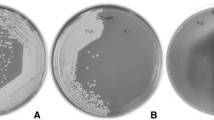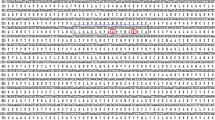Abstract
Genes for β-glucosidase (Bgl) isolated from a genomic library of the cellulolytic bacterium,Cellulomonas biazotea, were cloned in pUC18 in itsSacI cloning site and transformed toE. coli. Ten putative recombinants showed blackening zones on esculin plates, yellow zones on pNPG plates, in liquid culture and on native polyacrylamide gel electrophoresis activity gels. They fell into three distinct groups. Three representativeE. coli clones carried recombinant plasmids designated pRM54, pRM1 and pRM17. The genes were located on 5.6-, 3.7- and 1.84-kb fragments, respectively. Their location was obtained by deletion analysis which revealed that 5.5, 3.2, and 1.8 kb fragments were essential to code for BglA, BglB, and BglC, respectively, and conferred intracellular production of β-glucosidase onE. coli. Expression of thebgl genes resulted in overproduction of β-glucosidase in the three clones. Secretion occurred into the periplasmic fractions. Three inserts carryingbgl genes from the representative recombinantE. coli were isolated withSacI ligated in the shuttle vector pYES2.0 in itsSacI site and transformed toE. coli andS. cerevisiae. The recombinant plasmids were redesignated pRPG1, pRPG2 and pRPG3 coding for BglA1, BglB1 and BglC1. The cloned genes conferred extracellular production of β-glucosidase onS. cerevisiae and enabled it to grow on cellobiose and salicin. Thegall promoter of shuttle vector pYES2.0 enabled the organisms to produce twice more β-glucosidase than that supported by thelacZ-promoter of pUC18 plasmid inE. coli. The cloned gene can be used as a selection marker for introducing recombinant plasmids in wild strains ofS. cerevisiae The enzyme produced bybgl + yeast andE. coli recombinants resembles that of the donor with respect to temperature and pH requirement for maximum activity. Other enzyme properties of the β-glucosidases fromS. cerevisiae were substantially the same as those fromC. biazotea.
Similar content being viewed by others
References
Ashfaq S.M.R., Bashir A., Rajoka M.I., Malik K.A.: Rapid zymographic technique for the localization of cellulases on nondenaturing polyacrylamide gel, pp. 77–84 inBiotechnology for Energy (K. Maliket al., Eds). Pubs. NIAB/NIBGE, Faisalabad (Pakistan) 1991.
Ausubel F.M., Brent R., Kingston R.E., Moore D.D., Seidman J.G., Smith J.A., Struhl K.:Current Protocols in Molecular Biology, Green Publishing Associates and Wiley-John Willey & Sons, New York 1993.
Barron A., May G., Berner E., Villarejo M.: Regulation of envelope protein composition during adaptation to osmotic stress inEscherichia coli.J. Bacteriol. 167, 433–438 (1986).
Beckman K.: A cautionary note on the use of certain restriction endonucleases with methylated substrates.Gene 11, 169–171 (1980).
Coughlan M.P., Wood T.M., Montenecourt B.S., Mandels M.: Cellulases: production, properties, and applications.Biochem. Soc. Trans. 13, 405–416 (1985).
Deshpande V., Eriksson K.-E.: 1,4-β-Glucosidase ofSporotrichum pulverulentum.Methods Enzymol. 160, 415–424 (1988).
Esen A.: β-Glucosidases (over review), pp. 1–14 inβ-Glucosidases, Biochemistry and Molecular Biology (A. Esen, Ed.). American Chemical Society, Washington (DC) 1993.
Gadgil N.J., Daginawala H.F., Chakrabarti T., Khanna P.: Enhanced cellulase production by a mutant ofTrichoderma reesei.Enzyme. Microb. Technol. 17, 942–946 (1995).
Gilkes N.R., Kilburn D.G., Miller R.C., Warren R.A.J.: Bacterial cellulases.Biores. Technol. 36, 21–35 (1991).
Himmel M.E., Adney W.S., Fox J.W., Mitchell D.J., Baker J.O.: Isolation and characterization of two forms of β-d-glucosidase fromAspergillus niger.Appl. Biochem. Biotechnol. 39/40, 213–225 (1993).
Hoh Y.K., Yeoh H.H., Tan T.K.: Isolation and characterization of β-glucosidases fromAspergillus nidulans mutant USDB 1183.World J. Microbiol. Biotechnol 9, 555–558 (1993).
Honda H., Saito T., Iijima S., Kobayashi T.: Molecular cloning and expression of a β-glucosidase gene fromRuminococcus albus inEscherichia coli.Enzyme Microb. Technol. 10, 559–562 (1988).
Kim J.H., Pack M.Y.: Overproduction of extracellular endoglucanase by genetically engineeredBacillus subtilis.Biotechnol. Lett. 15, 130–133 (1993).
Kubicek-Pranz E.M., Gruber F., Kubiceck C.P.: Transformation ofTrichoderma reesei with the cellobiohydrolase II gene as a means for obtaining strains with increased cellulase production and specific activity.J. Biotechnol. 20, 83–94 (1991).
Latif F., Rajoka M.I., Malik K.A.: Production of cellulases by thermophilic fungi grown onLeptochloa fusca straw.World J. Microbiol. Biotechnol. 11, 347–348 (1995).
Nakamura K., Misawa M., Kitamura K.: Cellulase genes ofCellulomonas uda CB4. 1. Cloning and expression of β-glucosidase genes inE. coli.J. Biotechnol. 3, 239–246 (1986).
Parvez S., Rajoka M.I., Fariha F., Malik K.A.: Cloning of endoglucanase genes fromCellulomonas biazotea intoE. coli andS. cerevisiae using shuttle vector YEp 24.Folia Microbiol. 39, 251–254 (1994).
Rajoka M.I., Malik K.A.: Enhanced production of cellulases byCellulomonas strains grown in media containing different cellulosic residues.Folia Microbiol. 42, 59–64 (1997).
Rajoka M.I., Parvez S., Malik K.A.: Cloning of structural genes for β-glucosidase fromCellulomonas biazotea intoE. coli andSaccharomyces cerevisae using shuttle vector pBLU-D.Biotechnol. Lett. 14, 1001–1006 (1992).
Sami A.J., Akhtar M.W.: Purification and characterization of two low-molecular weight endoglucanases ofCellulomonas flavigena.Enzyme Microb. Technol. 15, 586–592 (1993).
Siddiqui K.S., Rashid M.H., Rajoka M.I.: Kinetic analysis of the active site of an intracellular β-glucosidase fromCellulomonas biazotea.Folia Microbiol. 42, 53–58 (1997).
Sprenger G.A., Typas M.A., Drainas C.: Genetics and genetic engineering ofZymomonas mobilis.World J. Microbiol. Biotechnol. 89, 17–24 (1993).
Tsujibo H., Ohtsuki T., Ho T., Yamazaki I., Miyamoto K., Sugiyama M., Inamori Y.: cloning and sequence analysis of genes encoding xylanases and acetyl xylan esterase fromStreptomyces thermoviolaceous OPC-520.Appl. Environ. Microbiol. 63, 661–664 (1997).
Author information
Authors and Affiliations
Corresponding author
Rights and permissions
About this article
Cite this article
Rajoka, M.I., Bashir, A., Hussain, S.R.A. et al. Cloning and expression of β-glucosidase genes inEscherichia coli andSaccharomyces cerevisiae using shuttle vector pYES 2.0. Folia Microbiol 43, 129–135 (1998). https://doi.org/10.1007/BF02816497
Received:
Revised:
Issue Date:
DOI: https://doi.org/10.1007/BF02816497




